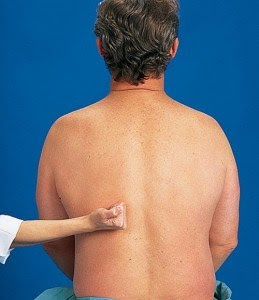Costovertebral angle tenderness Definition, Test, Causes, Treatment
Costovertebral angle tenderness is also known as CVA tenderness, murphy’s punch sign, pasternacki’s sign or gold flam’s sign. Costovertebral angle tenderness is a medical diagnostic test which is performed to check the pain intensity in the back side of area covering kidney. Costovertebral angle is formed between vertebral column and the coastal margin. In this test, percussion is done to the back side of waist in which tapping is performed on the surface to check the structure underlying.
The Costovertebral angle tenderness test is positive in person with kidney infection i.e. perinephric abscess, pyelonephritis, and hemorrhagic fever with renal syndrome and last but not least renal stones associated fever. Kidney is present just below the Costovertebral angle in waist. As tapping on the surface of Costovertebral angle causes the inflamed tissues of kidney to hit and pain is generated responding to it showing tenderness. The inflammation can also be checked by sliding hand over the Costovertebral angle and pressing upward into the Costovertebral angle area. If the patient respond to it, then the test result is positive and if the patient do not respond the Costovertebral angle tenderness test then the patient may not have any infection.

Costovertebral angle tenderness is a medical diagnostic test which is performed to check the pain intensity in the back side of area covering kidney. The Costovertebral angle is formed between vertebral column and the coastal margin. In this test, percussion is done to the back side of waist in which tapping is performed on the surface to check the structure underlying. . If the patient respond to it, then the test result is positive and if the patient do not respond to Costovertebral angle tenderness test then the patient may not have any infection.
Costovertebral angle test is performed to check the renal infections. The pain and tenderness is present at the side of kidney and mostly associated with one side. Renal stones can be a main cause behind inflammation as stones block the passage of urine and cause inflammation. So the Costovertebral angle tenderness test is performed to check the severity of condition. Pyelonephritis in which infection occurs due to viruses or bacteria. Abscess in kidney which surrounds the kidney also cause Costovertebral angle tenderness. Other causes include 12th rib fracture, herpes zoster and muscular injury of the back side due to trauma.
Costovertebral angle tenderness is due to many reasons so to treat Costovertebral angle tenderness the underlying cause should be treated. If the cause is the kidney stones, then the stones should be removed to clear the way out and ultimately the Costovertebral angle tenderness is reduced and diminishes with time. The patient is prescribed to take excess water which helps in clearing the stones. Antibiotics are also prescribed to remove stones from kidney and also to treat pyelonephritis. When the causes are treated, the tenderness of Costovertebral angle is also reduced and diminishes.
The Costovertebral angle tenderness test is positive in person with kidney infection i.e. perinephric abscess, pyelonephritis, and hemorrhagic fever with renal syndrome and last but not least renal stones associated fever. Kidney is present just below the Costovertebral angle in waist. As tapping on the surface of Costovertebral angle causes the inflamed tissues of kidney to hit and pain is generated responding to it showing tenderness. The inflammation can also be checked by sliding hand over the Costovertebral angle and pressing upward into the Costovertebral angle area. If the patient respond to it, then the test result is positive and if the patient do not respond the Costovertebral angle tenderness test then the patient may not have any infection.

Costovertebral angle Tenderness Test
Costovertebral angle tenderness is a medical diagnostic test which is performed to check the pain intensity in the back side of area covering kidney. The Costovertebral angle is formed between vertebral column and the coastal margin. In this test, percussion is done to the back side of waist in which tapping is performed on the surface to check the structure underlying. . If the patient respond to it, then the test result is positive and if the patient do not respond to Costovertebral angle tenderness test then the patient may not have any infection.
Costovertebral angle Tenderness Causes
Costovertebral angle test is performed to check the renal infections. The pain and tenderness is present at the side of kidney and mostly associated with one side. Renal stones can be a main cause behind inflammation as stones block the passage of urine and cause inflammation. So the Costovertebral angle tenderness test is performed to check the severity of condition. Pyelonephritis in which infection occurs due to viruses or bacteria. Abscess in kidney which surrounds the kidney also cause Costovertebral angle tenderness. Other causes include 12th rib fracture, herpes zoster and muscular injury of the back side due to trauma.
Costovertebral angle Tenderness Treatment
Costovertebral angle tenderness is due to many reasons so to treat Costovertebral angle tenderness the underlying cause should be treated. If the cause is the kidney stones, then the stones should be removed to clear the way out and ultimately the Costovertebral angle tenderness is reduced and diminishes with time. The patient is prescribed to take excess water which helps in clearing the stones. Antibiotics are also prescribed to remove stones from kidney and also to treat pyelonephritis. When the causes are treated, the tenderness of Costovertebral angle is also reduced and diminishes.
Costovertebral angle tenderness Definition, Test, Causes, Treatment
 Reviewed by Simon Albert
on
July 01, 2017
Rating:
Reviewed by Simon Albert
on
July 01, 2017
Rating:
 Reviewed by Simon Albert
on
July 01, 2017
Rating:
Reviewed by Simon Albert
on
July 01, 2017
Rating:











